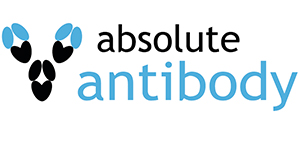Anti-CD147 (5F6)
Anti-CD147 [5F6], Recombinant, IgG1 kappa, Mouse
SKU
ABAAb03169-1.1-BT
Packaging Unit
1 mg
Manufacturer
Absolute Antibody
Availability:
loading...
Price is loading...
CloneID: 5F6
Antigen Long Description: The original antibody was generated by immunizing mice with CD147.
Buffer Composition: PBS only.
Uniprot Accession No.: P35613
Specificity Statement: The antibody binds the N domain of CD147. The antibody binds to an epitope on the extracellular domain of CD147 (residues Asp65-Phe74 and Val30-Thr40). CD147 is a type I membrane glycoprotein and is classified into the immunoglobulin-like superfamily, and is expressed in many types of cancer. It is suggested that CD147 is also associated with cancer metastasis, invasion, and chemical drug resistance.
Application Notes (Clone): The specificity of the antibody was coonfirmed by competition ELISA. The antibody recognized MDA-MB-231 cells that express native CD147 antigens on tumor cell surface. To assess the ability of the original antibody to block MMP-1 production, NHLF were treated with recombinant a ECD-Flag construct and the MMP-1 production in response to CD147 stimulation was determined using the MMP-1 activity assay. The antibody showed significant inhibition of MMP-1 production. The original antibody was screened for the ability to inhibit CD147-induced MMP-2 or MMP-9 production in co-culture. Results showed the antibody inhibited MMP-2 and MMP-9 production in co-culture. The humanized version of the antibody (IgG1) inhibited CD147-stimulated MMP-1 production by fibroblast in a dose-dependent manner and the MMP-2 production by MDA-MB-231 and NHDF in a dose dependent manner. The humanized version of the antibody was able to inhibit VEGF production by normal human lung fibroblasts (NHLF) stimulated with 10 μg/ml recombinant CD147 for 48 hours. The humanized version of the antibody inhibited more than 40% of VEGF production in co-culture of tumor cells and fibroblast cells. The humanized version of the antibody inhibited angiogenesis in vivo. SCID Beige Mice implanted with MDA-MB-231 human breast carcinoma cells were treated with E+5F6(MuIgG2a); the antibody inhibited tumor angiogenesis in Panc-1 matrigel plug model. The antibody showed potential as therapeutic and prophylactic agents (US8618264B2). The structure of the Fab fragment was determined (Teplyakov et al., 2010).
Antigen Long Description: The original antibody was generated by immunizing mice with CD147.
Buffer Composition: PBS only.
Uniprot Accession No.: P35613
Specificity Statement: The antibody binds the N domain of CD147. The antibody binds to an epitope on the extracellular domain of CD147 (residues Asp65-Phe74 and Val30-Thr40). CD147 is a type I membrane glycoprotein and is classified into the immunoglobulin-like superfamily, and is expressed in many types of cancer. It is suggested that CD147 is also associated with cancer metastasis, invasion, and chemical drug resistance.
Application Notes (Clone): The specificity of the antibody was coonfirmed by competition ELISA. The antibody recognized MDA-MB-231 cells that express native CD147 antigens on tumor cell surface. To assess the ability of the original antibody to block MMP-1 production, NHLF were treated with recombinant a ECD-Flag construct and the MMP-1 production in response to CD147 stimulation was determined using the MMP-1 activity assay. The antibody showed significant inhibition of MMP-1 production. The original antibody was screened for the ability to inhibit CD147-induced MMP-2 or MMP-9 production in co-culture. Results showed the antibody inhibited MMP-2 and MMP-9 production in co-culture. The humanized version of the antibody (IgG1) inhibited CD147-stimulated MMP-1 production by fibroblast in a dose-dependent manner and the MMP-2 production by MDA-MB-231 and NHDF in a dose dependent manner. The humanized version of the antibody was able to inhibit VEGF production by normal human lung fibroblasts (NHLF) stimulated with 10 μg/ml recombinant CD147 for 48 hours. The humanized version of the antibody inhibited more than 40% of VEGF production in co-culture of tumor cells and fibroblast cells. The humanized version of the antibody inhibited angiogenesis in vivo. SCID Beige Mice implanted with MDA-MB-231 human breast carcinoma cells were treated with E+5F6(MuIgG2a); the antibody inhibited tumor angiogenesis in Panc-1 matrigel plug model. The antibody showed potential as therapeutic and prophylactic agents (US8618264B2). The structure of the Fab fragment was determined (Teplyakov et al., 2010).
| SKU | ABAAb03169-1.1-BT |
|---|---|
| Manufacturer | Absolute Antibody |
| Manufacturer SKU | Ab03169-1.1-BT |
| Package Unit | 1 mg |
| Quantity Unit | STK |
| Reactivity | Human |
| Clonality | Recombinant |
| Application | ELISA, Blocking, In Vivo Assay, Inhibition |
| Isotype | IgG1 kappa |
| Host | Mouse |
| Product information (PDF) | Download |
| MSDS (PDF) | Download |

 Deutsch
Deutsch







